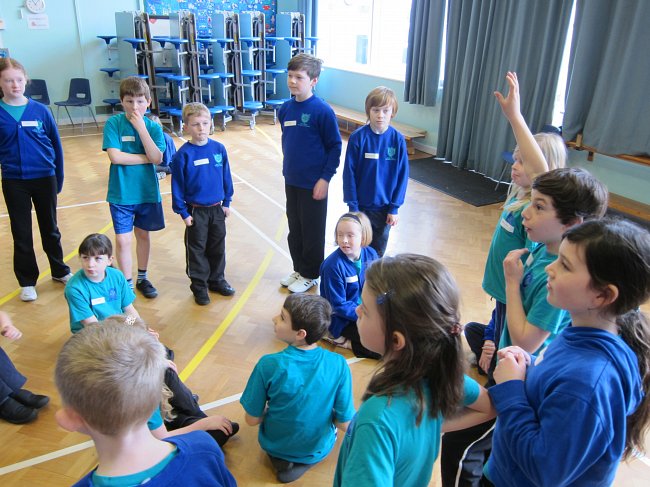
In September 2016 I started working with evaluator Emma McFarland, mentor Elsa Urmston, work placement Hannah Gibbs and the children and teachers of St Mary’s School in Byfleet to deliver a research project exploring ways of integrating dance within the primary school history curriculum. This work is supported by the Paul Hamlyn Foundation, through an ‘Explore and Test’ grant. Now that we're nearing the end of our first term, it felt like a good time to take stock of what we're learning, so I wanted to collect together some thoughts here. We will put together a more detailed review of the project in 2017.
Most of the photos throughout this post are from previous Made By Katie Green participation projects, but we will have more images from the children who have participated in the dance and history project for our final report.
What has happened so far?
In the first of our two partner schools, we have been helping two classes of children to learn about the Romans during a 1.5 hour session per class once a week. In this time, the children have to also complete a written task about their history topic, so we usually do 30-45 minutes of physical activity. Hannah and I support the children during their written activity as well as their dance session, and similarly the class teachers support the dancing as well as the writing. The children do their dancing in the school hall and their written task in the classroom, although we have gradually been trying to find ways of breaking down these distinctions, so the children write ideas on white boards during their dancing, and use their movement from the hall to help give structure to their writing in the classroom for example.
Progress has been really wonderful, and is even more striking because of where the children started. At the beginning of term, I asked the children to create a timeline of the Roman Empire by pegging a series of events in chronological order on a washing line, which was a precursor to them making a physical version of this timeline. Only one smaller group (7 or 8 children) out of the whole year were able to complete this in the time I gave them (5 minutes). We realised quickly that many of the children:
- weren’t accustomed to the autonomy required for this kind of task (it simply hadn't occurred to me that this task would be such a big step for them as I knew from a taster session and our discussions that the majority of the children had a good understanding of what a timeline was. I was using the washing line idea so the timeline could be mobile, so we could manipulate it, move the events around and take it back to the classroom)
- couldn’t work with other children effectively and, based on our initial discussions with some of the children, had fallen into a rut about this: the more difficult the majority of children in the class made group-working, the more frustrated the minority of the class found this, and the more difficult it became to create an environment in which any of the children could prosper
- many of the children had poor listening skills, and didn’t have good strategies to deal with what happened when they didn’t feel they were being heard
Having established these key issues really early on, I was able to change my approach (i.e. from a relatively open to a more directed approach), and, although there is a great deal of qualitative data that we will need to process at the end of the project to evidence our findings, the children are responding well to mixing dancing and writing within their history session on a weekly basis. For example:
- they have better focus/listening skills in both their dancing and writing activities
- they are performing with more conviction, grace/control and attention to the quality of their movement (and on the whole are happier to share their work with each other and not be embarrassed performing for their peers)
- they are remembering movement and historical content better, particularly when they are given a story to think of that connects that movement to their history task
- they are beginning to work more creatively, adding their own interpretation through adding more qualitative details about how it must have felt to be alive in the age of the Roman Empire for example
- they are working better in pairs and we have been able to introduce some contact work, which the children love to do
- some of the children who were quieter at the beginning of the term are coming out of their shell more; it is not the same children who are putting their hands up to answer questions all the time
- some of the children who seemed very confident at the beginning now don’t stand out so much, because the others are working up to the same level as them
- some of the children who have been disruptive (being silly, trying to draw attention) are not getting the same response that they used to from their peers, and so they’re not putting their energy into being disruptive any more. It’s interesting to observe how the children’s engagement and behaviour shifts in response to the engagement and behaviour of the other children – the group dynamic overall is very important in enabling us to progress.
- children who had difficulty working independently (i.e. joining in with learning a taught phrase, or making suggestions for their own movements) at the beginning of term are now more likely to join in
Of course, not all of the children are improving at the same rate. Now that we’re getting closer to the children’s performance in an assembly at the end of term, some of them who have shown so much development in their sessions when they’re just doing what they’re doing for themselves are still showing signs of reverting to old behaviours when we show any signs of preparing for performance. Some are still finding creative work challenging unless it is highly teacher-led. Some children are still opting out of the activity or being disruptive. We are continually trying to find new ways of involving everyone, but of course we are not in control of everything that might impact on the children's participation in any given week. I have been reminded again of the extent to which everything surrounding the project contributes to its effectiveness e.g. engagement of teachers and support staff, availability of hall (and whether we have it completely to ourselves), behaviour of other non-teaching staff, what has happened at lunchtime, the day or week before etc, and the time that is available to us as a result of the weighting given to different subjects in the curriculum. However, I know that every child has achieved something this term relative to where they started at the beginning, and we try whenever we can to celebrate all these achievements, large and small.
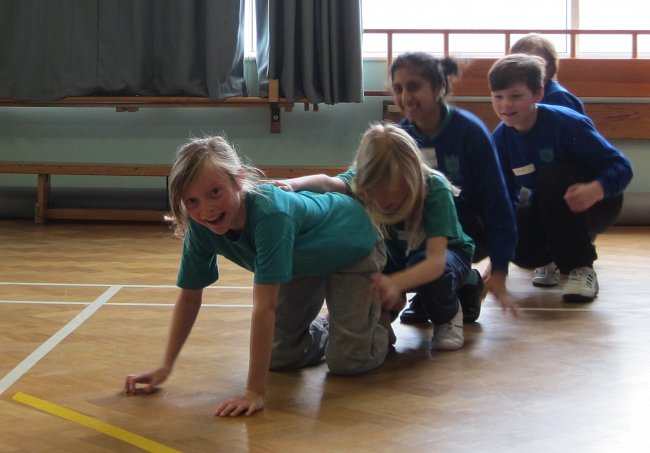
What is really significant for me is the way in which this project has taken me ‘back to basics’, reminding me of some things which seem so obvious as I write them down but are good to be reminded of, and never to be underestimated. The three most important of these are:
- the children have benefited from having a clear structure in place for the sessions; after the first workshop, I realised that I was progressing too quickly, and the children needed to understand more about what was expected of them before they would feel free to do their best and to be creative
As a result of setting up an environment in which the children have very clear guidelines and therefore know exactly what is expected of them (e.g. we agreed a code of conduct for the sessions, the children know where they stand in the room, how we warm-up, including games to develop listening skills, how we introduce our subject for each lesson, how we give feedback, how they are rewarded, how poor behaviour is managed) we are now getting to the point where the motivational climate in the room is closer to what I was hoping for at the beginning of the term. This means that the children are starting to offer their own solutions to creative tasks by making their own suggestions for interpretation of the subject matter, sometimes without me directly asking for them, and I am able to then integrate those suggestions into the movement phrases we’re working on. As the term has gone on, many of the children seem to have really enjoyed learning the phrases I have been teaching them, but as we start to integrate more input from them, they enjoy it even more. I am hoping to build on this as I hand over more to the children to design what their performance will be when they share it in a special assembly at the end of term.
- Positive, fair delivery (from the teacher), and positive reinforcement of the children’s effort at every opportunity is essential in nurturing enjoyment and diminishing any anxiety.
- Dancing is a healthy, fun activity which can impact on children’s coordination, control, creativity and quality of movement for example. Learning other subjects through dancing can also impact positively on their engagement with those other subjects, as well as their confidence and general behaviour, including their capacity to listen, work with other people and to be self-motivated.
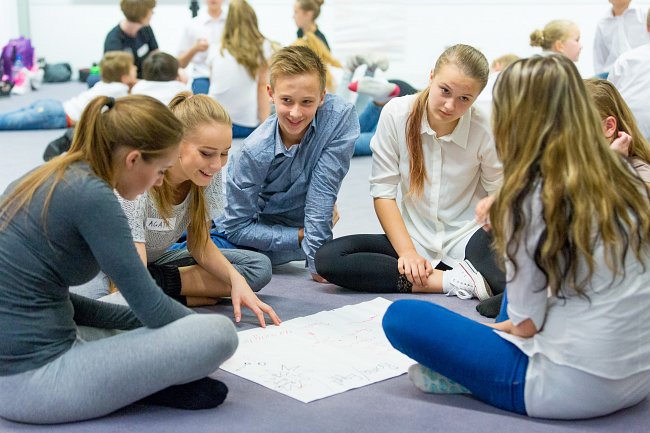
Here are some more things we're learning, relating back to my original research questions:
1. Can dance be used to teach history in a different way?
We've tried out a lot of specific tasks that have enabled us to bring the children's topic of the Romans to life, but thinking more generally, here are some approaches to content that have been working well:
- Using a simple repeating and developing warm-up, including tasks building listening skills, focus and cooperation (including spatial awareness), which can be as simple as asking the children to get into a circle with a time limit; on the whole, I am linking the warm-up activity to the history topic e.g. the children line up in ‘legions’ of different colours, I assign different ‘centurions’ every week and they get into different formations used by the Roman army (tortoise, orb, wedge)
- Introductory discussions that are quickly participatory, introducing ways of embodying historical ideas (i.e. giving example movement vocabulary) where possible, and encouraging the children to make their own suggestions from the very beginning of the class, and to be rewarded for doing so (giving them a space to share additional historical information that they have)
- Making these introductory discussions and other elements of the session like a game e.g. we gave the children lots of facts about the qualities they would need to be accepted into the Roman army, and then gave them a 'job interview' which required them to remember as many of these as possible and articulate them from their own perspective
- Movement that is inspired by historical context and encourages the children to have an embodied understanding of the experience about which they are learning (which is why site visits and using Loan Boxes from museums are so helpful) and therefore to think about what it must have been like to live in the time of the Roman Empire. For example, we have given events physical shape (e.g. we built Hadrian’s Wall and mapped out the Roman baths) and told stories with words and movement (e.g. training for the Roman army, a day in the life of a Roman child) in a very clear way that is aligned closely with the written task the children will also complete. The children enjoy phrases that have lots of movement content, including some challenging movement such as floor work or partner work, which have drama, which often means a strong intention and clear context (e.g. the Romans and the Celts intimidating each other before they engage in battle), enable them to explore different qualities and use pieces of music that the children enjoy. They help them to remember historical facts, but also to put their understanding of the Roman period into their own terms (which helps with their creative writing).
Movement inspired by activities from the children’s visit to Butser Ancient Farm worked particularly well, and the very fact that the children have now been in a Celtic Roundhouse and a Roman Villa, experiencing each space for themselves means that they are able to call to mind the differences between those cultures very easily and put them into movement.
- Keep things moving
The children prefer phrases with lots of movement content over more static discussion activities and seem to prefer pure movement above using any kind of ‘prop’ I have introduced for example (although these are good to add as an extra level of challenge after they’ve learnt a basic phrase, or if one group has completed a task and is ready to move on).
When the children went on their site-visit to Butser Ancient Farm, we changed one of their activities from pottery to building, and this was by far the most effective activity of the day, with all the children, including those who find focusing more difficult, excited to get stuck in. We have been able to use this building activity as a starting point for lots of movement we have made back at school.
Moving between spaces (i.e. from the school hall to the classroom in our weekly sessions and from site to site when we visited Butser Ancient Farm) has a positive impact on the children’s focus, and especially maintains the interest of those who find it hard to apply themselves for a length of time. When we had an opportunity to work in the school hall for the full 1.5 hour session, the children lost focus in the same way that they would if they were in a classroom. A change of scene can be as good as a rest, and the children have stopped asking for breaks entirely since we started dividing our time between hall and classroom.
All of these approaches require close collaboration with teaching staff, so that everyone understands the aims of each session and we can work towards achieving those together through both dance and written tasks.
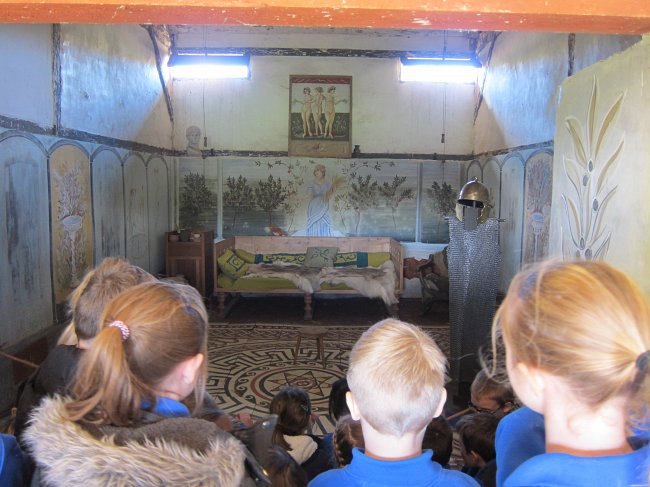
As I've indicated above, we have also discovered some teaching strategies that are more effective than others:
- Structure
As I have already described, although my more natural tendency would be to include a lot of small group creative work and opportunities for the children to integrate their own ideas, with this particular year group in this particular context (I’m sure it would be completely different in another setting) I have tended towards more teacher-led activities. Even where children have been working in small groups or pairs (which I have reintroduced slowly during the term), their tasks have been a great deal more focussed than they were when we started the project. Now that the children are becoming more familiar with the extent of the movement vocabulary available to them and we have shown them a range of ways in which they could interpret historical content physically, they are excited about integrating more of their own ideas.
I try to maintain a balance between some things that are more simple, familiar (e.g. repeating and developing warm up), and some more challenging (e.g. addition of contact work in our Hadrian’s Wall week) that keep the pace up, as well as maintaining the balance between talking, moving and writing.
- Crossover of learning styles from three different contexts (classroom, hall, off-site) to keep up pace and attention
Hannah, the teachers and I are continually encouraging the children to make links between what we are doing across learning contexts e.g. recalling work we did off-site in the school hall through looking back to pictures of the site visit; using pictures and video to recall hall-based activities in the classroom; using visual aids/key words to quickly set up a hub for information but in the hall rather than the classroom (where this might usually happen on the white board or interactive board) and then moving these visual aids around so they become reminders in the other spaces in which we work; asking the children to bring whiteboards and pens into the hall so the written activity can be more mobile and the children can try to capture what they’re inspired by in the moment, before using it later in their writing
- Calm delivery, lots of positive feedback, including when children are becoming disengaged or aggravated. I noticed that many of the children who had difficulty applying themselves in the sessions would write in their reflections at the end (and sometimes at the beginning) that they felt angry. This made me realise that if I could diffuse that anger somehow, e.g. by finding the thing that would enable them to connect with the activity - a personal connection, praise for something they had done well which they might have thought I didn’t notice, talking through a different approach to a task if they did not want to engage in the way I had suggested or finding something else they were interested in such as helping me to video the work-in-progress – the children were more likely to stay calm throughout the session and end on a positive note. This is the aim, and has worked on a handful of occasions, but I continue to try to work creatively to turn the children's anger into something else.
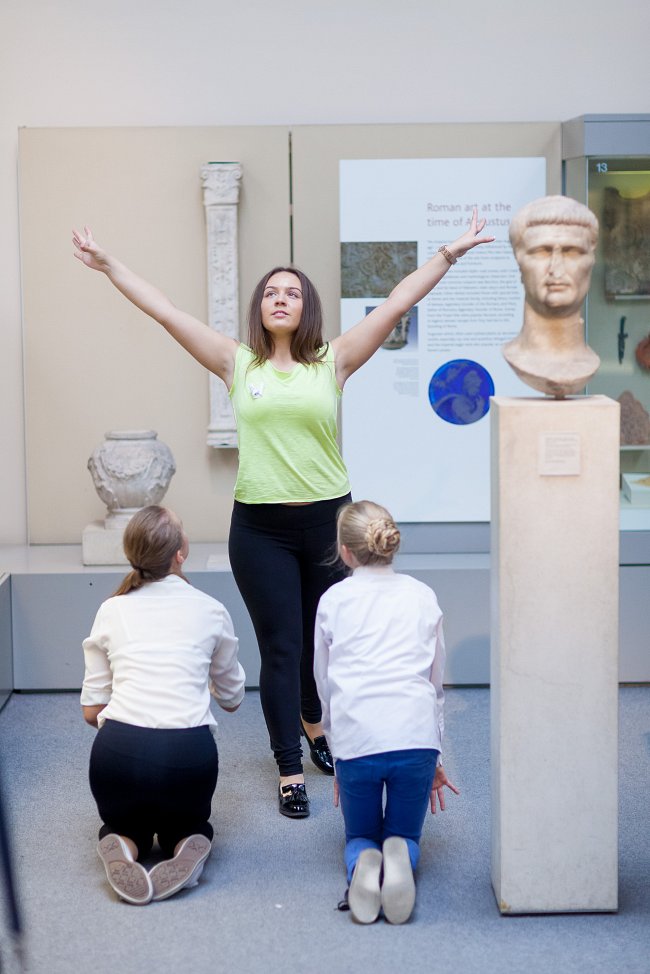
2. How does teaching history through dance impact upon the children’s self-confidence?
When leading dance workshops with primary school children through my Dancing in Museums project, either in schools or on-site at museums, I observed a greater change in participants than I had in other settings as I write about here. My current research project has, as I hoped, reinforced my belief in the benefits of this way of working, not only increasing children's engagement in history, but also impacting on other aspects of their work and behaviour e.g.:
- focus and listening skills - when all the children are focused, or can get back on track more easily when they become distracted, there is a massive impact on the overall morale of the group
- capacity to work with other people - I've observed that the children’s individual self-confidence is so often dependent on their relationship with other people, and by asking the children to effectively practice different kinds of (often spatial) relationship with other people through the choreography we have been doing together (getting into lines, into a circle, pitting the Celts against the Romans, replicating the formations of the Roman army, or creating a watch-tower on Hadrian's wall for example), we're also asking them to 'rehearse' what it might be like if they cooperate outside of their dance session too. Where a group activity is working well, and all participants feel equally valued and able to contribute as they would like, the children’s confidence and therefore pride in their work is very clear. Where there is a breakdown of communication, the children are quick to revert to being disruptive, to blame, or to withdraw because of their frustration at not being able to proceed. So a lot of my work this term has been focused on finding the best way to set up and manage creative tasks so that the children do not have this opportunity for their group work to break down.
- developing the children’s physicality and their dance skills as well as their engagement with history e.g. grace and control, conviction and attack, attention to the quality of movement as well as its purpose (they seem more assured when they understand the purpose of the movement/its context). I have certainly observed a link between the children’s development of this physical skill and their confidence i.e. as the children develop in confidence, they show this by performing their movement better as well, by becoming more excited about learning new movement material, and by enjoying showing me that they have remembered what we have done in previous sessions. To give an indication of just how far they have come, at the end of the summer term in July 2016, when I delivered taster sessions for the project and first met these children, I noted that many of them found even sitting down to be challenging, and would constantly fidget, roll, lie, recline but not sit. This is simply not an issue any more.
There’s more for me to do to discover how teaching history through dance can enable the children to shape their learning (although this is now starting to happen, and I hope we will work on this a great deal when rehearsing for the end of term performance, which the children will design themselves) and develop their capacity to be reflective. On the whole the children have responded well to awarding house points to each other based on their effort in their dancing and at the end of the term I am keen to talk to the children about whether or not they have been valuing the brief time they are given each week to reflect on how they are feeling and how things went for them in their history session on that particular day. I will also be doing more work with the teachers to see how we take this work forward, and to find out more about what the teachers would need from me to feel confident delivering their history topic in this way in the future.
Overall observations
At the moment I think that one of the findings of this research will be that yes, dancing can be used to teach history in a different way, but that the reasons why it is effective can be applied equally to other curriculum subjects. My specific interest is on developing the role of movement within the history curriculum given the focus of my choreographic work in museums and heritage sites, leading to frequent opportunities to work with children on-site in creative dance workshops, and my desire to do this to the best of my ability. The stories and experiences of history lend themselves to the idea of being physically embodied, with children today trying to step into the shoes of people of the past and tread in their footsteps. However, it is also possible (and I know it has been done) to use dance to embody a mathematical equation, the cause and effect of a scientific principle, to bring a painting to life, to create a physical map for example. Dance artists and in fact anyone who has an interest in integrating movement into their teaching practice knows this – as I say above, it seems obvious to the initiated. However, what I hope this project will help me do is to make a stronger case for the vitality of this work in schools in the future, backed up by information from children, teachers, artists and parents.